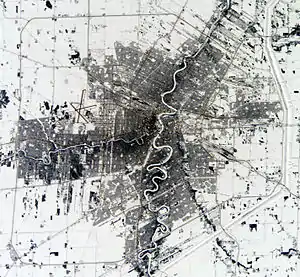Wildwood Park, Winnipeg
Wildwood Park (also spelled 'Wildewood') is a suburban community in Winnipeg that has a central green space and no front roads (only back alleys), with communal walkways, playgrounds and parks. Nearly all of the original houses are based on five variations of three basic designs, pre-fabricated in one section of the site. The site plan concept is based on the Radburn community design of architects Henry Wright and Clarence Stein who advocated the idea of designing neighbourhoods for the "motor age". It varies from the original in the introduction of crescents (or loops) as the local access roads. It was developed in 1946–47 by Hubert Bird and designed by Green, Blankstein, Russell (GBR). It is well known as an early example of the Radburn pattern, which has found extensive application in the second half of the 20th century. It presages the emergence of the fused grid that uses the same principle of filtered permeability.
Wildwood Park | |
|---|---|
Neighbourhood | |
 Wildwood Park | |
| Coordinates: 49.847°N 97.13°W | |
| Country | |
| Province | |
| Region | Winnipeg Metro Region |
| Established | 1946–47 |
| Government | |
| • MP | Jim Carr |
| • MLA | Mark Wasyliw |
| • Councillor | Sherri Rollins |
| Area | |
| • Neighbourhood | 1.3 km2 (0.5 sq mi) |
| • Metro | 5,306.79 km2 (2,048.96 sq mi) |
| Elevation | 232 m (761 ft) |
| Population (2016)[1] | |
| • Neighbourhood | 1,130 |
| • Density | 870/km2 (2,300/sq mi) |
| • Metro | 778,489 |
| Forward Sortation Area | R3T |
| Area code(s) | Area codes 204 and 431 |
Governance
Wildwood Park is in the Fort Rouge–East Fort Garry city ward and the Pembina Trails School Division of Winnipeg. It corresponds to Statistics Canada's census dissemination area 110466, in census tract 0503.00, within the Winnipeg census division, part of the Winnipeg census metropolitan area. It comprises much of the Wildwood neighbourhood of Winnipeg, within the Fort Garry North neighbourhood cluster (according to how census data is reported for the city of Winnipeg). It is in the Fort Garry provincial electoral division (Fort Garry-Riverview from 2008 to 2018) and the Winnipeg South Centre federal electoral division. Before the unicity amalgamation in 1972, this was part of the Rural Municipality of Fort Garry.
Further reading
- Don Gillmor (2005), "Urban Planning: Wildwood Childhood," Canadian Geographic, v 125, n 4 (July/August), p 54.
- Michael David Martin (2001), "Returning to Radburn," Landscape Journal, v 20, n 2, pp 156–175.
- Michael David Martin (2001), "The Landscapes of Winnipeg's Wildwood Park," Urban History Review, v 30, n 1 (October), pp 22–39.
- Michael David Martin (2002), "The Case for Residential Back-Alleys: A North American Perspective," in Journal of Housing and the Built Environment, v 17, n 2, pp 145–171.
- Michael David Martin (2004), "Designing the Next Radburn: A Green-hearted American Neighbourhood for the 21st Century", proceedings of Open Space/People Space: An International Conference on Inclusive Environments, Edinburgh: Research Centre for Inclusive Access to Outdoor Environments. ISBN 1-904443-03-6.
- Carl Nelson (1985), Wildwood Park Study, Ottawa: Canada Mortgage and Housing Corporation.
- Mavis Reimer (1989), Wildwood Park Through the Years, Winnipeg: Wildwood History Book Committee. ISBN 0-88925-831-7.
- Sigfried Toews (1973), A Tribute to Wildwood Park: a housing report for J. Lehrman, Winnipeg: University of Manitoba.
- (1948) "Operation Integrated: Two New House Designs, Site Selection, Wildwood Park, Fort Garry" in Builders' Bulletin, n 10 (March 6), Ottawa: Central Mortgage and Housing Corporation.
References
- "2016 Census Dada – Wildwood" (PDF). winnipeg.ca. July 24, 2019. Retrieved November 24, 2019.